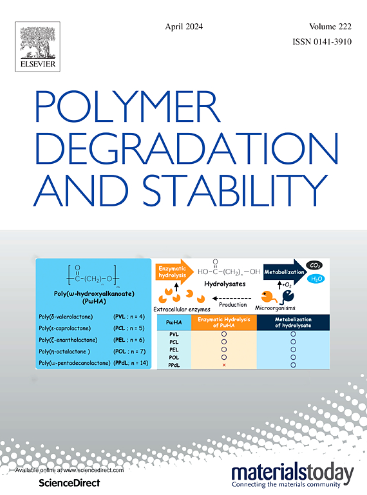How does DOPO flame retard polybutylene succinate? An in-depth mechanism investigation
IF 6.3
2区 化学
Q1 POLYMER SCIENCE
引用次数: 0
Abstract
9,10-dihydro-9-oxa-10-phosphaphenanthrene-10-oxide (DOPO) is an efficient phosphorus-based flame retardant which may act in the gas phase to flame retard polyesters. When it was incorporated at 10wt% loading in polybutylene succinate (PBS), it was observed, in mass loss cone test (MLC) that the time to ignition (TTI) was dramatically increased from 119 s to 467 s and 2206 s under a heat flux of 35 kW/m2 and 25 kW/m2 respectively. Various techniques have been used to investigate its mode of action. Mass spectra (MS) results indicate that the sublimation and thermal decomposition products of DOPO are formed in the gas phase. A large quantity of combustible gases (mainly tetrahydrofuran and succinic anhydride) was observed before ignition by an in-situ infrared spectra combining with MLC (IR-MLC). Therefore, decomposition/sublimation products of DOPO have a strong flame poisoning effect that prevents the material's ignition until the combustible gases reach a critical concentration and ignite.
DOPO 如何阻燃聚丁二酸丁二醇酯?深入机理研究
9,10-二氢-9-氧-10-磷菲-10-氧化物(DOPO)是一种高效的磷系阻燃剂,可在气相作用于阻燃聚酯。在质量损失锥试验(MLC)中,当载重为10wt%时,在35 kW/m2和25 kW/m2的热流下,点火时间(TTI)分别从119 s和467 s显著增加到2206 s。已经使用了各种技术来研究它的作用方式。质谱分析结果表明,DOPO的升华和热分解产物是在气相中形成的。利用原位红外光谱结合MLC (IR-MLC)技术,在点火前观察到大量可燃气体(主要为四氢呋喃和丁二酸酐)。因此,DOPO的分解/升华产物具有很强的火焰中毒作用,阻止材料着火,直到可燃气体达到临界浓度并点燃。
本文章由计算机程序翻译,如有差异,请以英文原文为准。
求助全文
约1分钟内获得全文
求助全文
来源期刊

Polymer Degradation and Stability
化学-高分子科学
CiteScore
10.10
自引率
10.20%
发文量
325
审稿时长
23 days
期刊介绍:
Polymer Degradation and Stability deals with the degradation reactions and their control which are a major preoccupation of practitioners of the many and diverse aspects of modern polymer technology.
Deteriorative reactions occur during processing, when polymers are subjected to heat, oxygen and mechanical stress, and during the useful life of the materials when oxygen and sunlight are the most important degradative agencies. In more specialised applications, degradation may be induced by high energy radiation, ozone, atmospheric pollutants, mechanical stress, biological action, hydrolysis and many other influences. The mechanisms of these reactions and stabilisation processes must be understood if the technology and application of polymers are to continue to advance. The reporting of investigations of this kind is therefore a major function of this journal.
However there are also new developments in polymer technology in which degradation processes find positive applications. For example, photodegradable plastics are now available, the recycling of polymeric products will become increasingly important, degradation and combustion studies are involved in the definition of the fire hazards which are associated with polymeric materials and the microelectronics industry is vitally dependent upon polymer degradation in the manufacture of its circuitry. Polymer properties may also be improved by processes like curing and grafting, the chemistry of which can be closely related to that which causes physical deterioration in other circumstances.
 求助内容:
求助内容: 应助结果提醒方式:
应助结果提醒方式:


